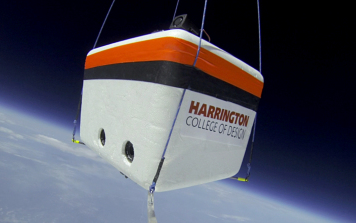‘’The first ever photograph of the earth from the stratosphere’’.
At Connectikpeople, we are proud to talk about this achievement and feat.
In fact, Connectikpeople has observed that, what began as a challenge for
students at Harrington College of Design in Chicago resulted in the first ever
photograph of the earth from the stratosphere , 95,000 feet above the planet’s
surface , using a toy Holga film camera.
Connectikpeople may recall that, this student-led project was part of a
15-week Modern Alternative Photographic Practices class, culminating
with the official balloon
launch Aug. 29, 2013. The original concept was to send something up to the stratosphere to photograph the earth, but the idea of using a Holga came from a student. Today’s Holga is the current incarnation of a line of inexpensive, medium-format film cameras created in 1982. Costing about $25, it’s a molded plastic box with a fixed shutter, plastic lens and a simple viewfinder. There is no prism, no auto-focus and no motor drive.
launch Aug. 29, 2013. The original concept was to send something up to the stratosphere to photograph the earth, but the idea of using a Holga came from a student. Today’s Holga is the current incarnation of a line of inexpensive, medium-format film cameras created in 1982. Costing about $25, it’s a molded plastic box with a fixed shutter, plastic lens and a simple viewfinder. There is no prism, no auto-focus and no motor drive.
Connectikpeople has also discovered that, ‘’since each camera would only
shoot a single image, the team strategically placed four Holgas in a repurposed
cooler, with holes cut on each side so a lens was pointed out on opposite sides.
The biggest challenge: How to trigger the four cameras while they floated in
bitter temperatures twenty miles above the earth’s surface. The Harrington
students tested several mechanisms before one developed a concept robust enough
to trip all cameras in near-freezing space temperatures, an automobile power
door lock actuator. For a trial launch, an old-fashioned alarm clock was gutted
and used as the timing mechanism, but that was replaced with a more reliable
modern photo timer for the second launch.
The second challenge was positioning the Spot II satellite GPS tracker. To
track the location and follow the cameras back to earth, the GPS needed to be
pointing toward the sky at all times. That wouldn’t be a problem while
suspended beneath the helium-filled weather balloon or floating down by
parachute, but if the styrofoam cooler landed on its back or nose, it could be
the difference between retrieving it or losing it. A student suggested placing
the GPS unit in a Gyro Bowl™, designed
to keep small children from spilling their food. The Spot II was a shade too
big to fit into the bowl, but Department Chair of Photography Programs Dirk
Fletcher didn’t let that stop them. Overnight, he created a fully functional
Gyro Bowl-inspired cradle that functions as a three-axis gimbal.
The final payload carried four Holgas with two tripping mechanisms, which
each fired two cameras at the same time. It took one hour and fifty-three
minutes to reach its highest altitude before the balloon popped, sending the
cameras back to earth on a parachute. The return took a mere 20 minutes and 59
seconds from the edge of space to a cornfield forty-five miles away’’.


